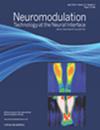临床实施基于感觉的帕金森病深部脑刺激初始规划:一项回顾性研究。
IF 3.2
3区 医学
Q2 CLINICAL NEUROLOGY
引用次数: 0
摘要
目的:使用单极回顾的初始深部脑刺激(DBS)程序是耗时、主观和繁重的。结合神经生理学有可能加快、客观化和自动化初始DBS编程。我们的目的是评估临床实施的基于感知的帕金森病(PD)初始DBS规划的可行性和性能。材料和方法:我们对15例PD患者(25个半球)进行了单中心回顾性研究,植入了具有传感功能的神经刺激器,在这些患者中,最初的丘脑下核/白白球内部DBS编程由实时局部场电位记录的β功率引导,而不是单极回顾。结果:最初基于感觉的编程访问平均持续42.2分钟(SD 18)每个半球。在DBS优化阶段,不需要对任何患者进行常规的单侧临床评价。在最后的随访中,除了三个半球外,所有半球的初始刺激接触水平保持不变。在最初基于传感的编程访问后,最终振幅平均比初始设置高0.8 mA (SD 0.9)。术后1年,国际帕金森与运动障碍学会统一帕金森病评定量表(MDS-UPDRS) III总评分、震颤亚评分、MDS-UPDRS IV和左旋多巴当量剂量较术前分别提高47.0% (p < 0.001)、77.7% (p = 0.001)、51.1% (p = 0.006)和44.8% (p = 0.011)。结论:本研究表明,基于感觉的PD初始DBS规划是可行的、快速的,并在大多数患者中选择了临床有效的接触者,包括震颤患者。技术创新和实际发展可以改善基于感知的编程。本文章由计算机程序翻译,如有差异,请以英文原文为准。
Clinically Implemented Sensing-Based Initial Programming of Deep Brain Stimulation for Parkinson’s Disease: A Retrospective Study
Objectives
Initial deep brain stimulation (DBS) programming using a monopolar review is time-consuming, subjective, and burdensome. Incorporating neurophysiology has the potential to expedite, objectify, and automatize initial DBS programming. We aimed to assess the feasibility and performance of clinically implemented sensing-based initial DBS programming for Parkinson’s disease (PD).
Materials and Methods
We conducted a single-center retrospective study in 15 patients with PD (25 hemispheres) implanted with a sensing-enabled neurostimulator in whom initial subthalamic nucleus/globus pallidus pars interna DBS programming was guided by beta power in real-time local field potential recordings, instead of a monopolar review.
Results
The initial sensing-based programming visit lasted on average 42.2 minutes (SD 18) per hemisphere. During the DBS optimization phase, a conventional monopolar clinical review was not required in any patients. The initial stimulation contact level remained the same at the final follow-up visit in all hemispheres except three. The final amplitude was on average 0.8 mA (SD 0.9) higher than initially set after the original sensing-based programming visit. One year after surgery, off-medication International Parkinson and Movement Disorder Society Unified Parkinson’s Disease Rating Scale (MDS-UPDRS) III total score, tremor subscore, MDS-UPDRS IV, and levodopa-equivalent dose improved by 47.0% (p < 0.001), 77.7% (p = 0.001), 51.1% (p = 0.006), and 44.8% (p = 0.011) compared with preoperatively using this approach.
Conclusions
This study shows that sensing-based initial DBS programming for PD is feasible and rapid, and selected clinically effective contacts in most patients, including those with tremor. Technologic innovations and practical developments could improve sensing-based programming.
求助全文
通过发布文献求助,成功后即可免费获取论文全文。
去求助
来源期刊

Neuromodulation
医学-临床神经学
CiteScore
6.40
自引率
3.60%
发文量
978
审稿时长
54 days
期刊介绍:
Neuromodulation: Technology at the Neural Interface is the preeminent journal in the area of neuromodulation, providing our readership with the state of the art clinical, translational, and basic science research in the field. For clinicians, engineers, scientists and members of the biotechnology industry alike, Neuromodulation provides timely and rigorously peer-reviewed articles on the technology, science, and clinical application of devices that interface with the nervous system to treat disease and improve function.
 求助内容:
求助内容: 应助结果提醒方式:
应助结果提醒方式:


